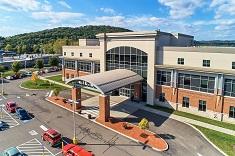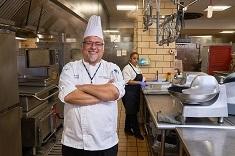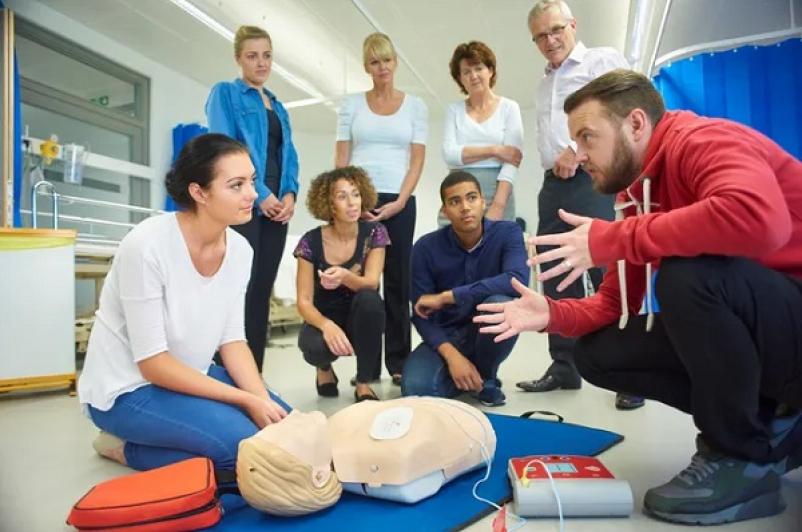
Cardiac arrest – the sudden loss of heart function due to an irregular heart rhythm – is a leading cause of death in the United States. When an individual suffers cardiac arrest, their survival depends on immediately receiving CPR from someone nearby. According to the American Heart Association, about 90% of people who experience a cardiac arrest outside of the hospital won’t survive. Performing CPR can double or triple the chance of survival for a cardiac arrest victim, especially if performed immediately.
That’s why June 1-7 has been designated National CPR and AED Awareness Week – bringing attention to how lives can be saved if more Americans know how to perform CPR and how to use an AED (automated external defibrillator). The American Heart Association, in coalition with the American Red Cross and the National Safety Council, campaigns annually to reinforce these life-saving skills and impress the importance of the willingness of bystanders to act in a cardiac arrest emergency.
Don’t wait to learn CPR
If a situation arises in which you must give CPR in an emergency, you will most likely be trying to save the life of someone you love, such as a child, a spouse, a parent, or a friend. Over 70% of out-of-hospital cardiac arrests occur in the home, and only about 40% of those who experience an out-of-hospital cardiac arrest will receive the immediate attention they need before professional help arrives.
Learning hands-only CPR can be the difference between life and death for someone you love. Hands-only CPR has been shown to be as effective as conventional CPR in the first few minutes of a cardiac arrest at home, at work, or in public – and it’s done in just two easy steps:
- Call 911 if you see an adult or teen suddenly collapse. The operator on the other end of the line can provide assistance while dispatching the emergency help you need.
- Push hard and fast in the center of the chest at a rate of 100 to 120 compressions per minute. Many people feel more confident remembering the correct rate when trained to the beat of a familiar song, such as “Stayin’ Alive” by the Bee Gees.
To watch a 90-second instructional video from the AHA, click here and share it with the important people in your life as an introduction to hands-only CPR. The AHA encourages everyone to learn conventional CPR as a next step.
The use of an AED also plays a critical role in helping those who experience sudden cardiac arrest. An AED, or automated external defibrillator, is a lightweight and portable device that delivers an electric shock through the chest to the heart when it detects an abnormal rhythm, changing the heart’s rhythm back to normal. To learn more about AEDs, click here.
AEDs are portable, safe, accurate, and easy – and they are intended to be used by the general public. Although formal AED training is not required to administer care with one, it is recommended to help increase your level of confidence when using the device.
To find and sign-up for a CPR and AED certification class with the American Red Cross, click here.
CPR and AED awareness in our community
As a healthcare leader in the Greater Binghamton region, UHS is committed to promoting essential education and resources regarding important health issues, including CPR and AED awareness.
UHS has partnered with the American Heart Association to provide CPR education to the community. In February, during American Heart Month, UHS and the AHA have donated CPR Anytime Training kits to local school districts and non-profit organizations – ensuring that our partners around the Greater Binghamton region have the tools to learn the life-saving skills of CPR, AED awareness, and choking relief.
UHS’ commitment to awareness extends beyond Heart Month, including a large annual turnout for the Southern Tier Heart Walk – which has raised over $5 million in the past three decades to support research, advocacy, CPR training, and heart health promotion.
UHS also provides AEDs to local non-profit organizations through the UHS Foundation’s partnership with the John Mack Foundation. This partnership created the John Mack Fund, which aims to provide education and access to life-saving defibrillators to support the prevention of sudden cardiac death. The fund carries out this mission by providing AEDs and raising awareness of the need for AEDs and CPR/AED-trained individuals who can provide emergency treatment to save lives.
Organizations interested in obtaining an AED can complete a request form on nyuhs.org. To learn more about the John Mack Fund, or to request an AED, click here.


